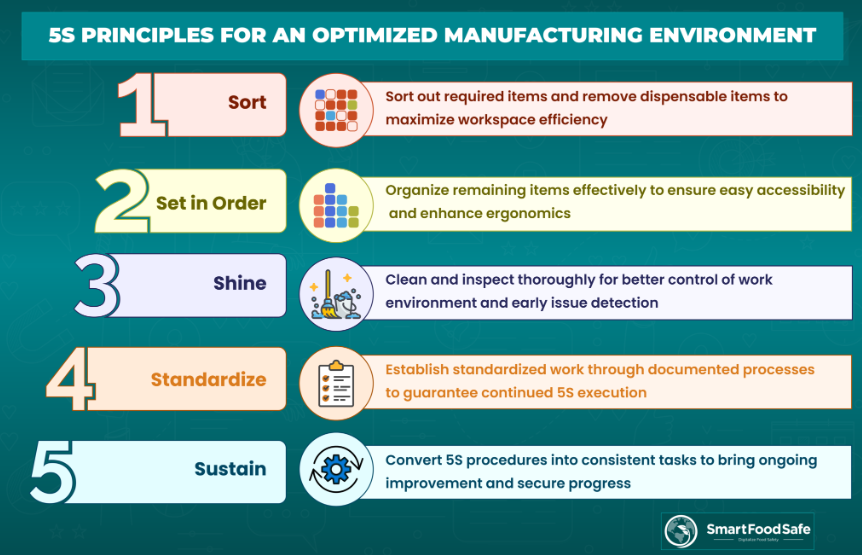
Ever heard of the philosophy, “a place for everything and everything in its place”? This is the core notion of the 5S methodology.
5S is a structured strategy aimed at optimizing workspaces for efficient, effective, and safe operations. It prioritizes placing items in their designated spots and maintaining cleanliness, streamlining tasks and reducing both time wastage and the potential for injuries, enabling smoother job execution.
The 5S approach originates from the Toyota Production System (TPS) as a Japanese organizational method developed in the early to mid-20th century. It is also considered the foundation of Total Productive Maintenance (TPM). It emphasizes the importance of a well-organized workplace to enhance functionality and workflow. This involves arranging the workspace based on task requirements and tool/material usage frequency.
SORT
Sort, as a crucial step in workspace organization, distinguishes between essential and non-essential items. The objective is to segregate items you regularly require from those that may not serve an immediate purpose, allocating the latter to a designated “red tag” holding area.
Eliminating waste from the workspace.
Disposing of broken or obsolete parts utilizing the 5S red tag system.
Responsible for recycling of materials and papers.
Distinguishing everyday tools from specialized ones.
Avoiding workspace clutter by refraining from excessive material accumulation.
Establishing an overflow area outside the primary workspace for duplicate tools, materials, or parts.
STRAIGHTEN
The Straighten phase involves meticulously arranging the remaining items post-sorting, facilitating easy access to frequently used items, and assigning each item a clear and easily locatable space.
Prioritize access to frequently used items for efficiency in daily tasks.
Categorize remaining items logically and brainstorm optimal storage methods for each category.
Implement visual cues for quick identification of missing or displaced items. For instance, employing shadow boards for tools is a classic method.
Utilize containers where applicable for item organization.
Use labeling techniques, such as framing larger items and adding labels for easy identification.
SHINE
The Shine process involves uplifting the work area by thoroughly cleaning and inspecting tools, equipment, and other items. It comprises routine maintenance, directly aligning with TPM (Total Productive Maintenance). It cultivates a work environment that actively engages operators by granting them increased responsibility and control over their workspaces. It also aids in early problem detection before they disrupt production.
Use appropriate cleaners and cleaning tools to make the work area shine. The goal of sweeping, mopping, brushing, wiping, washing, and waxing is to restore the workspace’s pristine condition.
Identify the root cause. The core principle of this 5S step is ‘cleaning for comprehension.’ If there are indications of leaks, spills, or unexpected debris, strive to comprehend their source, as these often serve as early warnings of potential future problems.
Inspect. Post-cleaning, take time to scrutinize each item and assess its condition, ensuring whether it requires updates, maintenance, or repair.
STANDARDIZE
Standardize serves as the link between the initial three steps of 5S (Sort, Straighten, Shine) and the final step (Sustain). Standardizing makes 5S a repeatable process, transforming it from a one-time endeavor into a set of reproducible activities.
Document in pairs: Pair a team member performing each 5S task with another who documents it to avoid missing important details.
Capture the essence: Reinforce simplicity by capturing the core of each task without unnecessary complexity, making maintenance of documentation easier.
Prefer checklists: Use concise checklists as reminders, with brief task names and more detailed descriptions for training purposes.
Organize for simplicity: Structure your checklists based on roles, shifts, and frequency (daily, weekly, monthly) to reduce intimidation and facilitate smoother execution for your team.
SUSTAIN
The Sustain refers to the continuous application of 5S principles. It converts standardized 5S procedures into regular tasks, ensuring constant adherence. Once standardization is achieved, it is required to act on those standards regularly.
Establish a schedule: Integrate 5S practices as routine tasks based on roles, shifts, and frequency.
Teach through demonstration: Train employees by demonstrating 5S tasks clarifying expectations for independent task execution.
Transition to independent work: Post initial training, gently supervise employees as they cultivate habits, offering guidance and corrections as needed to prevent mistakes or deviation.
Adaptation as needed: Identify areas for task improvement to enhance efficiency when providing or receiving feedback. Remember, standardized work should evolve and adapt as necessary.
Encourage suggestions through continual feedback for enhancing 5S processes, embracing each idea with genuine interest and a willingness to learn.
Smart Food Safe is a comprehensive suite of digital modules that leverages capabilities to elevate the performance of multiple facets of a manufacturing industry, which can come in handy to simplify the incorporation of 5S principles.
Digitalized Record-Keeping: Enable the ease of efficient storage and retrieval of records, allowing for a more streamlined documentation process, ascertaining that all necessary information regarding 5S steps is readily accessible and structured.
Workflow Management System: An automated workflow equips companies to visualize and have an overview of the various processes involved in the 5S application by designating accountability, tracking progress, and assisting in the systemic management of 5S.
IoT Integration for Monitoring: Integrating Internet of Things (IoT) technology to monitor the conditions of equipment, workspaces, or processes, ushering in a clean and safe environment by leading the way for advanced analytics and predictive insights.
Digital SOPs & Training: Tech-enabled creation and sharing of standardized operating procedures (SOPs) ensure everyone follows the same protocols. Employees can be further educated on the skills and knowledge required for reliably accomplishing 5S strategies through a digital learning management system (LMS).
Task Management: The organized system brought forth by 5S principles can be continually maintained and improved upon with adequate task management involving setting up schedules, assigning clearly defined responsibilities, keeping an eye on any nonconformances, and their swift mitigation.
Data Analytics and Reporting: Analyzing data with intuitive reporting tools collected from the system offers an inner look into areas of improvement, identifying bottlenecks, and interpreting the impact of 5S measures for informed decision-making and corresponding actions.
_1.png)